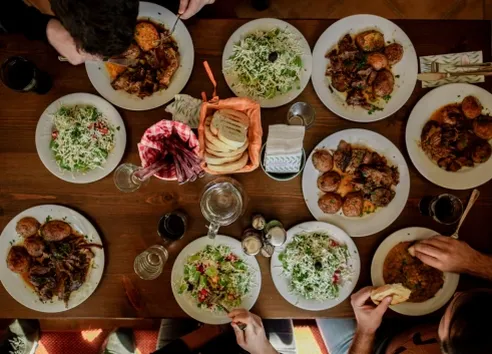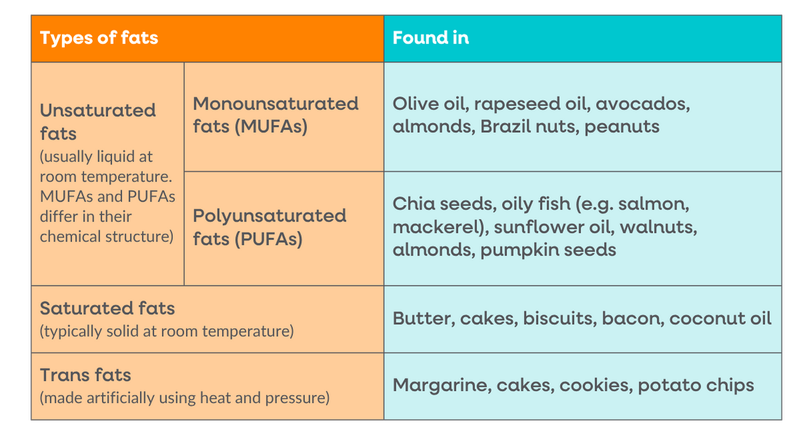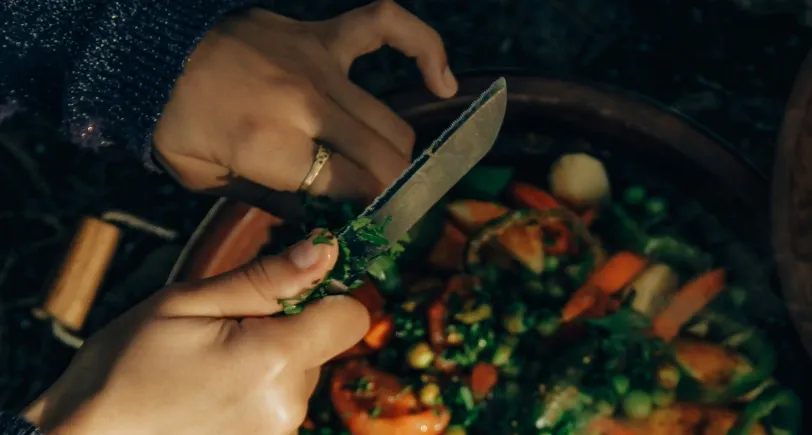Diet and breast cancer.
What is the link?

Can a healthy diet reduce your breast cancer risk?
Your diet may influence your risk of developing cancer, including breast cancer. Some foods or food components may be protective, while others may increase your risk. Because the effects of a healthy diet on your breast cancer risk take a long time to show, consistent, long-term healthy eating is crucial.
There is no single ideal diet for breast cancer prevention; rather, it is more important to consider the overall balance and proportions of different food groups.
Many diets can support your health and help reduce your risk, including the Mediterranean diet and balanced plant-based diets. These diets typically focus on whole, minimally processed foods, with plenty of fruit, vegetables, and high-fibre foods, while limiting or avoiding red and processed meats.
Tips to help improve your diet.
Eat a rainbow of colourful fruit and vegetables.
The more variety, the better, especially red, orange and yellow varieties rich in carotenoids. Ideally, seasonal and locally produced.
Choose whole grains and include some unsweetened dairy or dairy alternatives.
Whole Grains: Look for wholemeal bread, brown rice, and wholewheat pasta. Dairy/Alternatives: Examples include yogurt or fortified soy drinks.
Choose lean proteins.
Such as fish, poultry, beans and nuts. Eat less red meat and processed meats like bacon and sausages.
Key facts about diet and breast cancer risk.
A diet high in fruits and vegetables (especially non-starchy vegetables and those rich in carotenoids), whole grains, and fibre may help reduce your risk of breast cancer.
Eating less red and processed meats, unhealthy fats, added sugars, and ultra-processed foods can help you maintain a healthy weight and may reduce your breast cancer risk.
Some micronutrients may have protective effects, but supplements are not recommended for breast cancer prevention.
Adopting a healthy diet, like the Mediterranean or a plant-based diet, may help reduce your breast cancer risk. These diets focus on eating whole, minimally processed foods.

Ask the scientist: Can a healthy diet impact breast cancer risk?
Eating habits that may influence your breast cancer risk.
Fruits and vegetables.
A diet high in fruits and vegetables may help reduce the risk of breast cancer. Eating more non-starchy vegetables and foods rich in carotenoids (natural pigments, typically yellow, orange, and red) (see infographic below) may lower the risk of oestrogen receptor-negative (ER-) breast cancer.
Fruits and vegetables provide fibre, antioxidants, and other beneficial plant nutrients that may help protect our cells from damage and support overall health.
Examples of fruits and vegetables high in carotenoids or that are non-starchy.
How to eat more fruit and vegetables:
- Eat a wide variety of fruit and vegetables (including those rich in carotenoids) every day to ensure a good mix of different nutrients – no single fruit or vegetable provides all the nutrients you need to be healthy.
- Aim for at least three portions of non-starchy vegetables and two portions of fruit daily (around 400g in total).
- Try gentle cooking methods, such as steaming or lightly frying in olive oil at low temperatures, to preserve nutrients and avoid excess fat.
Carbohydrates and fibre.
Carbohydrates are the body’s main source of energy, and are found in foods such as bread, rice, pasta, fruit, legumes and vegetables. There are two main types: simple (e.g. sugar and glucose) or complex (e.g. starches found in foods like potatoes, wholegrains and pulses) carbohydrates.
The evidence linking total carbohydrates or sugar intake to an increased breast cancer risk is limited. Some studies suggest a possible link between added sugar or foods that cause rapid spikes in blood sugar and an increased risk, but results are mixed.
Diets high in added sugar can promote weight gain. Being overweight or obese is a risk factor for breast cancer in men and post-menopausal women.
There is growing evidence that diets high in fibre are associated with a lower risk of breast cancer.
Read our fibre page for more details.
How to eat the right amount of carbohydrates and fibre:
- Choose complex carbohydrates such as wholegrains, legumes, and vegetables. They provide long-lasting energy, promote fullness, and support a healthy weight.
- Eat around 30g of fibre per day from foods like wholemeal bread and pasta, oats, lentils, beans, and fruit and vegetables.
- Eat less foods with added sugars, commonly found in soft drinks, biscuits, cakes, and sweets. These are high in simple carbohydrates and are high in calories, but little nutrients.
Fats.
Fats have many essential functions in the body, including supporting hormone production and helping absorb fat-soluble vitamins (A, D, E, and K).
The main types of fats found in foods are unsaturated, saturated, and trans fats (see infographic below for examples and how they differ from each other).
Unsaturated fats are generally beneficial, while saturated and trans fats are best limited.
Studies suggest that eating a high amount of unsaturated fat, known as polyunsaturated (see below for more details), may reduce your risk of breast cancer. Eating a high level of trans fats, saturated fats, and dietary cholesterol may increase your risk.
Although eating some fat is part of a healthy diet, it is high in calories. A diet high in fat can lead to weight gain, a well-established risk factor for breast cancer in men and post-menopausal women.
How to eat the right fats:
- Less than 30% of your total calorie intake should come from fats.
- Include foods rich in unsaturated fats (see table 2 below). These are needed to stay healthy and to help maintain normal cholesterol levels.
- Eat less food that is high in saturated fats and avoid trans fats where possible (see below).
Types of fats and where they are found.
Red and processed meat.
Red meat (such as beef, pork, lamb or goat) is a good source of protein. However, if eaten in high amounts (more than 90g cooked weight a day) it may increase your breast cancer risk. However, evidence remains mixed and inconclusive.
Processed meat (e.g. ham, sausages, bacon, tinned meats) has been linked to a slightly increased breast cancer risk.
How to eat less red and processed meat:
- Replace red and processed meat with organic poultry, sustainably sourced fish, or non-meat protein such as soybeans, nuts, eggs, tofu, or meat substitute (like mycoprotein – made from fermented fungus).
- Limit red meat to no more than 3 portions per week, or roughly 350–500g (12–18oz) of cooked meat per week.
- Avoid processed meat or only consume in very small amounts, if any.
Ultra Processed Foods (UPFs).
Processed foods are foods that have been altered in some way during preparation. Foods can be grouped based on how much they have been processed. The NOVA classification system places foods into four categories:
Classification of foods based on how much they are processed (NOVA classification) and examples.
Diets high in UPFs have been linked to several health issues, including weight gain and obesity. These are known risk factors for breast cancer in men and post-menopausal women.
Studies suggest that eating more UPFs may be directly linked to a higher risk of breast cancer. However, further research is needed.
How to eat less processed food:
- Eat less packaged snacks, sugary drinks, and ready meals.
- Avoid food that has a long list of ingredients on the label. This is a sign that the food has been over-processed.
- Choose whole or minimally processed foods, such as fruit, vegetables, wholegrains, legumes, nuts and seeds.
- Try cooking your meals at home using fresh and seasonal ingredients. Download our seasonal calendar to help you.
Dairy and calcium.
Eating moderate amounts of dairy products (e.g. milk, cottage cheese, yoghurt) may be linked to a reduced risk of breast cancer, possibly because of their calcium content.
Fermented dairy products like yoghurt or kefir contain probiotics (live microorganisms), which can influence the gut microbiota and may be beneficial in helping to reduce breast cancer risk, though more research is needed.
How to eat the right amount of dairy and calcium:
- Choose unsweetened (no added sugar) dairy products like (organic) natural yoghurt, cottage cheese, and reduced-fat milk. These are good sources of calcium, protein, iodine, and B vitamins.
- Avoid sweetened yoghurts and flavoured milk drinks, which can be high in added sugar and calories.
- Try fermented dairy products such as yoghurt or kefir to benefit from their probiotic bacterial cultures that support gut health.
Preparing a healthy meal.
Soy and soy-based foods.
There is growing evidence that eating soy foods in moderation may be associated with a reduced risk of breast cancer.
Soy contains isoflavones, which are naturally occurring plant compounds that have a similar structure to the hormone oestrogen.
While there have been concerns that these might promote hormone-sensitive cancers, there is no convincing evidence that eating soy increases your breast cancer risk.
Soy and soy-based foods such as tofu, tempeh, and soy drinks are a good source of unsaturated fats, plant-based protein, B vitamins, iron, calcium, zinc, and other compounds beneficial to your health.
How to add soy to your diet:
- Try adding 1-2 portions of minimally processed soy-based foods per day, such as tofu, unsweetened soy yoghurt, soy milk, edamame and tempeh (fermented soybeans).
- Speak to your healthcare professional before taking isoflavone supplements.
Micronutrients and supplements.
Micronutrients are vitamins and minerals that are essential for your health but are only needed in small amounts.
Studies suggest certain micronutrients (e.g. vitamin D3, folate, and vitamin B6) may have protective effects against breast cancer.
The evidence on nutritional supplements and breast cancer risk remains limited.
For information on vitamin D supplements, see our vitamin D page.
The World Cancer Research Fund recommends meeting nutrient needs through a balanced, varied diet and does not recommend the use of supplements for cancer prevention.
Start your prevention journey today.
Take one of these simple steps today to improve your diet:
- Choose a piece of fruit over crisps for your next snack.
- Look at what you're about to eat and see if you can add any vegetables. Toss a handful of spinach into your sandwich or a side of baby carrots with your lunch.
- Download our free Organic Flavours recipe book and cook a healthy meal tonight.
Remember, every small change you make adds up over time.
Disclaimer:
The information has been written for members of the UK public. If you have been diagnosed with breast cancer, before changing any aspect of your diet, please consult a medical professional.
Breast Cancer UK is a breast cancer prevention charity and is unable to offer specific advice about the diagnosis or treatment of breast cancer. If you are worried about any symptoms, please consult your doctor.
Further reading
For more details and references, please see our Diet and Breast Cancer risk science review.
Last review: Aug-25 | Next review: Aug-28.
-
- Farvid MS, Chen WY, Rosner BA, Tamimi RM, Willett WC, Eliassen AH. Fruit and vegetable consumption and breast cancer incidence: Repeated measures over 30 years of follow-up. Int J Cancer 2018;144:1496. https://doi.org/10.1002/IJC.31653.
- Farvid MS, Barnett JB, Spence ND. Fruit and vegetable consumption and incident breast cancer: a systematic review and meta-analysis of prospective studies. Br J Cancer 2021;125:284. https://doi.org/10.1038/S41416-021-01373-2.
- AICR, WCRF. Diet, nutrition, physical activity and breast cancer: a global perspective. Continuous Update Project Report 2018. https://www.wcrf.org/wp-content/uploads/2024/10/Breast-cancer-report.pdf
- Dehnavi MK, Ebrahimpour-Koujan S, Lotfi K, Azadbakht L. The Association between Circulating Carotenoids and Risk of Breast Cancer: A Systematic Review and Dose–Response Meta-Analysis of Prospective Studies. Advances in Nutrition 2024;15. https://doi.org/10.1016/j.advnut.2023.10.007.
- Harvard Health. The Nutrition Source - Carbohydrates n.d. https://nutritionsource.hsph.harvard.edu/carbohydrates/ (accessed August 5, 2025).
- Ubago-Guisado E, Rodríguez-Barranco M, Ching-López A, Petrova D, Molina-Montes E, Amiano P, et al. Evidence update on the relationship between diet and the most common cancers from the european prospective investigation into cancer and nutrition (Epic) study: A systematic review. Nutrients 2021;13:3582. https://doi.org/10.3390/NU13103582/S1.
- Nielsen TG, Olsen A, Christensen J, Overvad K, Tjønneland A. Dietary carbohydrate intake is not associated with the breast cancer incidence rate ratio in postmenopausal Danish women. Journal of Nutrition 2005;135:124–8. https://doi.org/10.1093/jn/135.1.124.
- Romieu I, Ferrari P, Rinaldi S, Slimani N, Jenab M, Olsen A, et al. Dietary glycemic index and glycemic load and breast cancer risk in the European Prospective Investigation into Cancer and Nutrition (EPIC). American Journal of Clinical Nutrition 2012;96:345–55. https://doi.org/10.3945/ajcn.111.026724.
- Debras C, Chazelas E, Srour B, Kesse-Guyot E, Julia C, Zelek L, et al. Total and added sugar intakes, sugar types, and cancer risk: Results from the prospective NutriNet-Santé cohort. American Journal of Clinical Nutrition 2020;112:1267–79. https://doi.org/10.1093/ajcn/nqaa246.
- Pomares-Millan H, Saxby SM, Al-Mashadi Dahl S, Karagas MR, Passarelli MN. Dietary Glycemic Index, Glycemic Load, Sugar, and Fiber Intake in Association with Breast Cancer Risk: An Updated Meta-analysis. Nutr Rev 2025;83:1171–82. https://doi.org/10.1093/NUTRIT/NUAF038,.
- Farvid MS, Spence ND, Holmes MD, Barnett JB. Fiber consumption and breast cancer incidence: A systematic review and meta-analysis of prospective studies. Cancer 2020;126:3061–75. https://doi.org/10.1002/CNCR.32816,.
- NHS. Facts about fat n.d. https://www.nhs.uk/live-well/eat-well/food-types/different-fats-nutrition/ (accessed August 6, 2025).
- Hanson S, Thorpe G, Winstanley L, Abdelhamid AS, Hooper L, Abdelhamid A, et al. Omega-3, omega-6 and total dietary polyunsaturated fat on cancer incidence: systematic review and meta-analysis of randomised trials. Br J Cancer 2020;122:1260. https://doi.org/10.1038/S41416-020-0761-6.
- Buja A, Pierbon M, Lago L, Grotto G, Baldo V. Breast cancer primary prevention and diet: An umbrella review. Int J Environ Res Public Health 2020;17:1–54. https://doi.org/10.3390/IJERPH17134731,.
- Wolk A. Potential health hazards of eating red meat. J Intern Med 2017;281:106–22. https://doi.org/10.1111/JOIM.12543,.
- Rezaianzadeh A, Ghorbani M, Rezaeian S, Kassani A. Red Meat Consumption and Breast Cancer Risk in Premenopausal Women: A Systematic Review and Meta-Analysis. Middle East J Cancer 2018;9:5–12. https://mejc.sums.ac.ir/article_42096_40e4971f3cfa0d1e3463f9eab76199ba.pdf
- NHS. Meat in your diet 2024. https://www.nhs.uk/live-well/eat-well/food-types/meat-nutrition/ (accessed August 21, 2025).
- Huang Y, Cao D, Chen Z, Chen B, Li J, Guo J, et al. Red and processed meat consumption and cancer outcomes: Umbrella review. Food Chem 2021;356. https://doi.org/10.1016/j.foodchem.2021.129697.
- World Cancer Research Fund. Limit consumption of red and processed meat | Recommendation evidence n.d. https://www.wcrf.org/research-policy/evidence-for-our-recommendations/limit-red-processed-meat/ (accessed August 19, 2025).
- Scott Livingston A, Cudhea F, Wang L, Martinez Steele E, Du M, Claire Wang Y, et al. Effect of reducing ultraprocessed food consumption on obesity among US children and adolescents aged 7-18 years: evidence from a simulation model - Supplemental Materials Supplemental Text. BMJ Nutr Prev Health 2021;0. https://doi.org/10.1136/bmjnph-2021-000303.
- Lane MM, Gamage E, Du S, Ashtree DN, McGuinness AJ, Gauci S, et al. Ultra-processed food exposure and adverse health outcomes: umbrella review of epidemiological meta-analyses. BMJ 2024;384. https://doi.org/10.1136/BMJ-2023-077310.
- Fiolet T, Srour B, Sellem L, Kesse-Guyot E, Allès B, Méjean C, et al. Consumption of ultra-processed foods and cancer risk: results from NutriNet-Santé prospective cohort. BMJ 2018;360:322. https://doi.org/10.1136/BMJ.K322.
- Shu L, Zhang X, Zhu Q, Lv X, Si C. Association between ultra-processed food consumption and risk of breast cancer: a systematic review and dose-response meta-analysis of observational studies. Front Nutr 2023;10:1250361. https://doi.org/10.3389/FNUT.2023.1250361/FULL.
- Chang K, Gunter MJ, Rauber F, Levy RB, Huybrechts I, Kliemann N, et al. Ultra-processed food consumption, cancer risk and cancer mortality: a large-scale prospective analysis within the UK Biobank. EClinicalMedicine 2023;56:101840. https://doi.org/10.1016/j.eclinm.2023.101840.
- Godos J, Tieri M, Ghelfi F, Titta L, Marventano S, Lafranconi A, et al. Dairy foods and health: an umbrella review of observational studies. Int J Food Sci Nutr 2020;71:138–51. https://doi.org/10.1080/09637486.2019.1625035,.
- Savaiano DA, Hutkins RW. Yogurt, cultured fermented milk, and health: A systematic review. Nutr Rev 2021;79:599–614. https://doi.org/10.1093/NUTRIT/NUAA013,.
- Wei Y, Lv J, Guo Y, Bian Z, Gao M, Du H, et al. Soy intake and breast cancer risk: a prospective study of 300,000 Chinese women and a dose–response meta-analysis. Eur J Epidemiol 2020;35:567–78. https://doi.org/10.1007/S10654-019-00585-4,.
- Kazemi A, Barati-Boldaji R, Soltani S, Mohammadipoor N, Esmaeilinezhad Z, Clark CCT, et al. Intake of various food groups and risk of breast cancer: A systematic review and dose-response meta-analysis of prospective studies. Advances in Nutrition 2021;12:809–49. https://doi.org/10.1093/advances/nmaa147.
- Boutas I, Kontogeorgi A, Dimitrakakis C, Kalantaridou SN. Soy Isoflavones and Breast Cancer Risk: A Meta-analysis. In Vivo 2022;36:556–62. https://doi.org/10.21873/INVIVO.12737,.
- Messina M, McCaskill-Stevens W, Lampe JW. Addressing the soy and breast cancer relationship: Review, commentary, and workshop proceedings. J Natl Cancer Inst 2006;98:1275–84. https://doi.org/10.1093/JNCI/DJJ356,.
- Harvard Health. The Nutrition Source - Straight Talk About Soy n.d. https://nutritionsource.hsph.harvard.edu/soy/ (accessed August 7, 2025).
- World Health Organisation (WHO). Health Topics - Micronutrients n.d. https://www.who.int/health-topics/micronutrients#tab=tab_1 (accessed August 8, 2025).
- Mokbel K, Mokbel K. Chemoprevention of Breast Cancer With Vitamins and Micronutrients: A Concise Review. In Vivo 2019;33:983. https://doi.org/10.21873/INVIVO.11568.
- Lopes CM, Dourado A, Oliveira R. Phytotherapy and Nutritional Supplements on Breast Cancer. Biomed Res Int 2017;2017. https://doi.org/10.1155/2017/7207983,.
- Forma A, Grunwald A, Zembala P, Januszewski J, Brachet A, Zembala R, et al. Micronutrient Status and Breast Cancer: A Narrative Review. Int J Mol Sci 2024;25:4968. https://doi.org/10.3390/IJMS25094968.
- World Cancer Research Fund (WCRF). Do not use supplements for cancer prevention | Recommendation evidence n.d. https://www.wcrf.org/research-policy/evidence-for-our-recommendations/supplements/ (accessed August 8, 2025).
- Xiao Y, Xia J, Li L, Ke Y, Cheng J, Xie Y, et al. Associations between dietary patterns and the risk of breast cancer: A systematic review and meta-analysis of observational studies. Breast Cancer Research 2019;21:1–22. https://pmc.ncbi.nlm.nih.gov/articles/PMC6352362/





